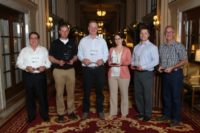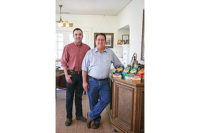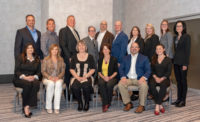Joseph Gallo Farms is using speed, eco-friendly practices and quality to compete with the giant cheesemakers and the small artisan operations on the West Coast.
To become more efficient, the mid-sized California dairy farmer and cheesemaker has made a series of capital improvements to cut time out of the cheesemaking process. Higher-speed cut-and-package machines with greater throughput have made the cheesemaker more efficient, while new testing equipment delivers results in seconds rather than minutes.
On the sustainability front, investments in co-generation systems are paid back quickly through savings on electric bills, and aggressive re-use and recycling efforts drop money to the bottom line every year.
When it comes to quality, a company-wide communications and training initiative has informed all 444 employees that every job function – from the CEO to maintenance personnel – affects quality.
CEO Michael Gallo has a rather broad definition of “quality” when the word is applied to cheese. In addition to the conventional technical and sensory aspects, he says “quality” also means creating safe foods, delivering great customer service and even keeping the plant clean. A visitor to the cheese plant in Atwater, Calif., saw employees pushing brooms outside in the receiving area and inside the finished goods warehouse.
“We are training to be pro-active not reactive,” said Quality Assurance Manager and Director of Food Safety Vince Burress.
Gallo is the second-generation manager of the Atwater, Calif.-based dairy processor (founded by his father Joseph in 1946. See related article, “Joseph Gallo Farms is California’s ‘green’ cheesemaker”) Peter Gallo, one of Mike’s sons and a member of the third generation, is working in the family business.
The company makes 19 types of cheese, including Jack, Cheddar, mozzarella (pasta filata and stir curd), Gouda, Muenster and Provolone varieties. Monterey Jack is the best seller. Many cheeses have been honored in professional and consumer cheese competitions. Blue ribbons and trophies are on display in the corporate offices. The company also converts whey into dairy ingredients for human and animal consumption.
The cheesemaker’s art (and science)
Making good cheese consistently, batch after batch, is part art and part science. Anyone can add the ingredients in the right measure, but a skilled cheesemaker watches how they interact and makes adjustments. No one knows this better than Plant Manager Mike Lenz.
“Every batch is different, even though it’s all milk, culture, salt and rennet,” Lenz said. The bacteria and the starter make cheese “a living thing,” Lenz said. “You can’t see the bacteria but it has a history.”
The art and science of cheesemaking come in at various stages in the process. A good cheesemaker uses senses (like touch, smell and vision) as well as the tools (like pH meters). Lenz is looking for responses. “You have to watch the curd,” he said and know when to cut it. It’s all about the technique, he said.
The employees in the plant take ownership of the cheesemaking process, Lenz said. They are cross-trained on making the various cheeses.
Burress led Dairy Foodson a tour of the 32-year-old cheese plant that has been expanded and improved over the years. Joseph Gallo Farms cow’s milk is free of all artificial hormones, including rBST, from its own dairy operation and it sources additional supply from local certified dairies. It uses only milk from Holstein and Jersey breeds.
Milk is piped directly from the milking parlor to the cheese plant, a practice that has eliminated 3,000 deliveries a year, reduced diesel fuel consumption and resulted in other cost savings.
The cheese complex consists of the cheese plant where cheese is made and the packaging building where it is sliced and packaged. There are separate warehouses for aging and for finished goods.
The cheese room contains vats, block tower formers and conveyors. Originally, Gallo made cheese with open tables and cheese racks. Over time, the plant acquired enclosed vessels, vats and tables. There are six vats, four tables and five towers. The processing capacity is 175,000 gallons of milk daily.
Pasteurized milk is pumped into the cheese vats where the starter is added. After curd formation, the curds are stirred and cut, then poured onto a table where the whey drains away. The curds are salted and pumped to the block tower formers. As the cheese falls through the formers, a wire harp cuts blocks weighing approximately 40 pounds. Blocks are sealed in bags, conveyed through a metal detector and boxed. The cardboard boxes act as forms to help the still-warm cheese keep its shape. Then the blocks are weighed on a scale and labeled. They are aged in a cool 20,000-square-foot warehouse for three to six weeks.
Then a quality control team of four highly trained cheese graders evaluates the cheese. They pull plugs to taste and test for texture, appearance, aroma, butterfat, pH and other levels. Packaging is re-checked for code date, seal and alignment. If the block passes muster, the QC team applies a quality assurance sticker on the block and it is released to the cut-and-wrap operation.
Pallets of cheese move from the production room to a separate building which has four lines for slicing and wrapping. (Fresh cheeses — pasta filata and mozzarella — are packaged on three lines in the cheese production building.)
Cut and wrap
After employees remove the blocks from the cartons, they put them on conveyors which lead to the cutting and packaging lines. (The cardboard cartons are recycled and the plastic liners are re-used.) On one line, blocks pass through a slicer and are broken down into loaf sizes and weighed. If too heavy, an employee carves off a little by hand. If the loaf is underweight, it is removed from the line and will be shredded. Correct-weight blocks go through the packaging line and are labeled according to customer specifications.
Because consumers (and retailers) want variety packs, Joseph Gallo Farms installed a machine that can collate different cheeses into one package, for instance Monterey Jack and Pepper Jack. If a customer wants paper leaves between slices, the machine can place them. This versatile piece of equipment can also handle zippered packages.
This fall, Gallo will install a new shredding machine in response to customer and consumer demand for shredded cheese. The new machine is five times faster and more efficient than the older version, Burress said.
After cheeses are sliced and wrapped, the packages are packed into cases. The cases are transferred to the 30,000-square-foot finished goods warehouse, which is overseen by Warehouse Manager Rodney Ford. Pickers come through to build orders, which can range from less than a full pallet to multiple pallets. Delivery trucks are loaded at the four bays.
Food safety, employee safety
Cheesemaking goes on around the clock in three shifts, but the packaging schedule varies. When the last shift ends about 1 a.m., the cleaning and sanitizing team gets to work. The cleaning crew swabs for bacteria. A visitor can identify work teams by their footwear. The cheese processor uses a color-coded boot system for food safety to avoid contamination. The maintenance team wears black boots; the production team is in blue; and those working on the pasta filata line wear green.
The cheese plant is regulated by the California Department of Agriculture, the U.S. Department of Agriculture and the federal Food and Drug Administration. In addition to safe food practices, Joseph Gallo Farms makes employee safety a top priority. Lift tables with rotating tops make loading pallets more ergonomically correct. A vacuum lift in the protein plant will eliminate the necessity of lifting 44-pound bags of powder. Pre-shift stretching in all departments makes sure that employees are warmed up and their muscles are loose prior to working. The company also established an employee safety reward program.
Elsewhere on the grounds is a building for processing dairy ingredients. Here, Gallo processes whey powders for human and animal consumption. Gallo bought a new dryer that reduced processing time from 22 hours to 12 hours. Whey from the cheese operation is pumped here. Through a variety of processes, including nanofiltration, ultrafiltration and reverse osmosis, water is removed from the whey to concentrate proteins into whey protein isolate, which is sold to food and beverage processors. The byproducts of this process are Pro Cream and whey permeate, which are used as cattle feed supplements.
The whey team has become more efficient at extracting more protein from the whey. Some protein was getting into the animal feed product, which Gallo called “a waste of valuable product.” For his company to develop the booming market for value-added protein ingredients will require further upgrading, Gallo said.
An on-site dairy lab, directed by Kathy Alamo, is staffed by six technicians. The lab operates around the clock, testing the physical and chemical make-up of the cheese and raw materials. The lab sends samples to an outside testing agency to verify accuracy. Alamo’s team also conducts a test on the fat value of every incoming load of milk.
“It’s important in order to get the value from the product,” she said, explaining that cream is an expensive ingredient.
Technicians test cheeses and powders for components, such as protein, moisture and ash content, for example. They also run microbiological tests on in-line cheese and finished cheese to verify that the products are within the company’s specifications. Equipment includes infra-red and near-infra-red analyzers with tight tolerances. The investment in NIR equipment has improved efficiencies. With this equipment, the lab can receive results in 30 seconds compared to 5 minutes with older equipment.
Sustainability saves money
Speed of production and high standards for quality have made Joseph Gallo Farms an efficient and profitable cheesemaker. The company’s sustainability practices also save money every year. In March, the Innovation Center for Dairy Research honored Joseph Gallo Farms with its Outstanding Dairy Processing and Manufacturing Sustainability award. In 2013, the cheesemaker received the Governor’s Environmental and Economic Leadership Award from the state of California. The award, known as the GEELA, is California’s highest and most prestigious environmental honor.
Gallo, a modest man, said he is pleased by the honors but he puts the recognition in perspective. “As a farmer, you want to be sustainable,” he said. In other words, it’s just something you do. But that position really downplays just how deeply Joseph Gallo Farms is into sustainable farming and processing.
Nothing goes to waste on the dairy farm or in the cheese plant. Manure from the dairy farm is digested in a 7-acre lagoon under thick black rubber blankets that capture methane gas which is burned to power electrical generators in the cheese plant. The methane digester co-generation system produces up to 1,500 kilowatt hours of electricity and captures 25,000 tons per year of greenhouse gases with no flaring. The savings are estimated at $3,000 a day. The plant also recaptures the steam to heat boilers. This practice saves $560,000 a year and eliminates 400,000 gallons of propane annually.
Supplies such as cardboard, plastic, batteries, tires, wooden pallets, engine oils, metals and LDPE bags are re-used or recycled. Even the company’s headquarters, a farmhouse, was relocated from elsewhere on the property. The company’s goal, which it shares with employees through training and communication, is zero injuries, zero emissions and zero waste.
Specifically, the company reuses and recycles more than 252 tons of corrugated cardboard annually. This saves disposal costs as well as trees. Joseph Gallo Farms has eliminated 400,000 gallons of propane and more than 70,000 gallons of diesel fuel. The company has recycled 77.7 tons of LDPE plastic and 5,720 gallons of engine oil. The methane digester captures 25,000 tons per year of CO2 greenhouse gases. The company accepts 6 to 10 million gallons of storm and wastewater from two nearby communities, eliminating a possible pollutant. It reuses the water for irrigation.
The cheese plant reclaims 100% of the effluent and uses it to flush the dairy lanes. The water is then cleaned and used to irrigate crops in the fields. This one practice alone conserves 1.8 million gallons of water every day. Overall, the company estimates it conserves and re-uses 8 to 12 million gallons of water every day. This is especially significant because the dairy processor is located in California’s Central Valley, the state’s major agricultural zone, which has been under drought conditions for two years.
For a dairy processor to adopt any sustainable practice, such as recycling or conserving water or reducing miles driven is admirable. Joseph Gallo Farms has embraced all of these areas and has fully committed to following sustainable farming and food processing practices. Yet despite what Joseph Gallo Farms has achieved to date, Mike Gallo said he “can always do more, much more.”
At-A-Glance
Joseph Gallo Farms
Atwater, Calif.
Year opened: 1982. Various expansions and renovations since then.
Employees: 61 in cheese production, 31 in the warehouse. 444 company-wide
Products made: 19 types of cheeses, including mild, medium and sharp Cheddar; Monterey Jack, marbled Jack; pepper Jack; mozzarella (curd, part skim low-moisture, low-salt, whole milk); Colby; Provolone; Muenster.
Pasteurization: 1 high-temperature short-time unit; 170 gallons a minute capacity
Silos: Four milk (total capacity 140,000 gallons), two whey (40,000 gallons), two cream (12,000 gallons)
Cheesemaking equipment: Six vats, four tables, five towers
Warehouses: Block storage (20,000 square feet), finished goods (30,000 square feet)
Photos by Kelly Powers Photography








